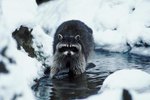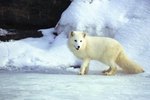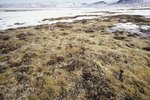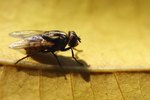
The subarctic climate covers a large portion of the earth's northern interior lands. The long, brutal winters and short, mild summers make the living conditions harsh for most animals. Fortunately, several species of animals have adapted to the subarctic seasons and have created an interesting biodiversity in the subarctic zones
Subarctic Across the Globe
The subarctic regions of the world have cold, harsh winters and short, mild summers. Seasonal temperature changes in the subarctic zones have the widest range of any climate areas in the world, ranging from −40 °F in the winter to up to 86 °F in the summer. Subarctic regions always are inland, away from the coastal zones, which help to moderate temperature changes. Across the globe, subarctic regions include most of Siberia, interior Alaska and most of Canada, most of Iceland and northern Scandinavia. Because of the brutal winters and short summers, animals living in the subarctic regions must be hardy and well-adapted to this harsh climate.
The Hunters at the Top of the Food Chain
The subarctic regions are home to some of the most magnificent hunters on the planet. The dominant Grizzly and black bears have adapted well to life in subarctic forests. During the summer months, they store food and fat reserves, preparing for the bleak winter months. As the temperatures begin to drop, they build a den in the hillsides and hibernate. Bears can hibernate and live off of their fat reserves for up to seven months, avoiding the months of icy temperatures and scarce food.
The subarctic wolf also prowls the subarctic regions. Related to his northern cousin, the white arctic wolf, and his southern cousin, the grey wolf, the subarctic wolf has adapted well to the region. These wolves follow the migrating herds of elk, caribou and deer, ensuring a regular food source.
Other predators in the subarctic climates include wolverines, red and arctic foxes, and lynxes.
Migrating Herds of the Subarctic
The subarctic regions are home to some of the most striking herds of migrating animals. Caribou, moose, elk, reindeer, musk oxen, mountain goats, Dall sheep and deer all call the subarctic home. These animals have adapted to harsh climates, learning to eat not only grasses in the summer, but also tree bark, brush, berries, small fruits and even mushrooms. Their fur also has adapted to form insulating layers to keep them warm in the cold winter months.
Small Creatures in the Subarctic
The subarctic zones are home to a variety of smaller creatures. Snowshoe hares, beavers and river otters all call the subarctic regions home. Several smaller rodents also thrive in the subarctic, including mice, rats, lemmings, voles and squirrels. All of these small mammals play an important part in the biological diversity of the subarctic.
Unlike mammals, which have adapted to life in the harsh temperature, reptiles cannot adapt to such extreme temperatures. As a result, the subarctic regions do not have a wide variety of reptiles.
References
Resources
Photo Credits
-
Jupiterimages/liquidlibrary/Getty Images




